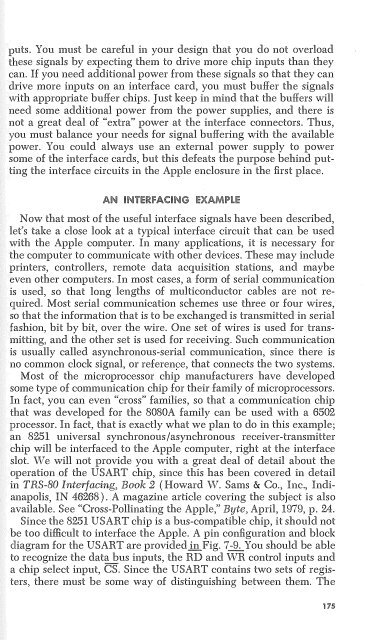Create successful ePaper yourself
Turn your PDF publications into a flip-book with our unique Google optimized e-Paper software.
puts. You must be careful in your design that you do not overload<br />
these signals by expecting them to drive more chip inputs than they<br />
can. If you need additional power from these signals so that they can<br />
drive more inputs on an interface card, you must buffer the signals<br />
with appropriate buffer chips. Just keep in mind that the buffers will<br />
need some additional power from the power supplies, and there is<br />
not a great deal of "extra" power at the interface connectors. Thus,<br />
you must balance your needs for signal buffering with the available<br />
power. You could always use an external power supply to power<br />
some of the interface cards, but this defeats the purpose behind putting<br />
the interface circuits in the Apple enclosure in the first place.<br />
AN INTERFACING EXAMPLE<br />
Now that most of the useful interface signals have been described,<br />
let's take a close look at a typical interface circuit that can be used<br />
with the Apple computer. In many applications, it is necessary for<br />
the computer to communicate with other devices. These may include<br />
printers, controllers, remote 'data acquisition stations, and maybe<br />
even other computers. In most cases, a form of serial communication<br />
is used, so that long lengths of multiconductor cables are not required.<br />
Most serial communication schemes use three or four wires,<br />
so that the information that is to be exchanged is transmitted in serial<br />
fashion, bit by bit, over the wire. One set of wires is used for transmitting,<br />
and the other set is used for receiving. Such communication<br />
is usually called asynchronous-serial communication, since there is<br />
no common clock signal, or referene, that connects the two systems.<br />
Most of the microprocessor chip manufacturers have developed<br />
some type of communication chip for their family of microprocessors.<br />
In fact, you can even "cross" families, so that a communication chip<br />
that was developed for the 8080A family can be used with a 6502<br />
processor. In fact, that is exactly what we plan to do in this example;<br />
an 8251 universal synchronous/ asynchronous receiver-transmitter<br />
chip will be interfaced to the Apple computer, right at the interface<br />
slot. We will not provide you with a great deal of detail about the<br />
operation of the USART chip, since this has been covered in detail<br />
in TRS-80 Interfacing, Book 2 (Howard W. Sams & Co., Inc., Indianapolis,<br />
IN 46268) . A magazine article covering the subject is also<br />
available. See "Cross-Pollinating the Apple," Byte, April, 1979, p. 24.<br />
Since the 8251 USART chip is a bus-compatible chip, it should not<br />
be too difficult to interface the Apple. A pin configuration and block<br />
diagram for the USART are provided in Fig. 7JLYou should be able<br />
to recognize the data bus inputs, the RD and WR control inputs and<br />
a chip select input, CS. Since the USART contains two sets of registers,<br />
there must be some way of distinguishing between them. The<br />
175

















